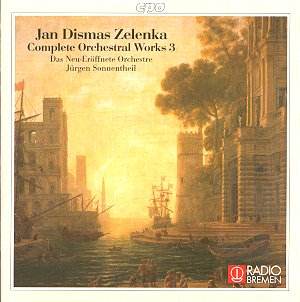Jan Dismas ZELENKA
(1679-1745)
Complete Orchestral Works Volume three.
 Das Neu-Eroffnete Orchestre
(period instruments)/Jurgen Sonnentheil
Das Neu-Eroffnete Orchestre
(period instruments)/Jurgen Sonnentheil
 CPO 999 697 -2 (DDD)
[58.17]
CPO 999 697 -2 (DDD)
[58.17]
Crotchet
AmazonUK AmazonUS

This is an elegant recording.
Jan Dismas Zelenka was born in Bohemia in 1679 and taught by the Jesuits.
He joined the Dresden Court Ensemble as a double bass player around 1710
and later studied with Fux and, later still, taught liturgical music at the
flourishing Catholic court in Dresden becoming a composer of sacred music.
Some of this work is very fine.
From about 1733, and for the next thirty years, the music dictates were in
the hands of Frederich August the Second and, ,for reasons that are obvious,
Zelenka turned to secular works although he did compose five masses between
1736 and 1741.
He was a fine musician but never made the top grade. As with more modern
composers like Myaskovsky in Russia he was respected rather than valued.
His music is basically baroque, of course, but has an elegance and refinement
that is praiseworthy particularly in these performances noted for an impeccable
style and clarity. One cannot say that it is great music but careful listening
will produce moments of real quality.
I found the performances perhaps a little too refined, so highly polished
at times that it seems like an exercise in making music pristine rather than
just making music. The small forces used give it a chamber music feel which
I am not sure is right. Nonetheless the playing, performances and sound are
very good.
The Overture for seven concertante instruments is a long work lasting
about 25 minutes and in these days one easily forgets what an overture was
in the 18th century. There are four movements, the overture itself in simple
ABA form, there is a very telling Aria and the third movement has two minutes
again in an ABA and, after a siciliano, the work ends with a folie.
Exquisitely played if a little too restrained for my taste.
The Symphonia from the Melodrama of St Wenceslas introduces trumpets
and timpani but, again, I felt the performances somewhat restrained. Other
performances I have heard of this piece have been very robust and I think
that works far better. There is a danger that if music lacks the right attack
it can so easily become background music only and therefore be deprecated.
The Capriccio no. 4 includes hair-raising parts for two corno da caccia.
It is in seven movements lasting twenty five minutes. Again larger forces
and a greater bite would have helped but, notwithstanding that, the performances
have a refinement and a polish which some may think is a little too much.
Let's perform music for music's sake and for music's sake alone not to revel
in affectation of style and longeurs.
David Wright
(See review of organ works by Wilhelm
Middlelschulte played by the conductor of this disc, Jurgen Sonnethiel)

